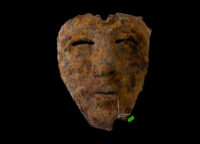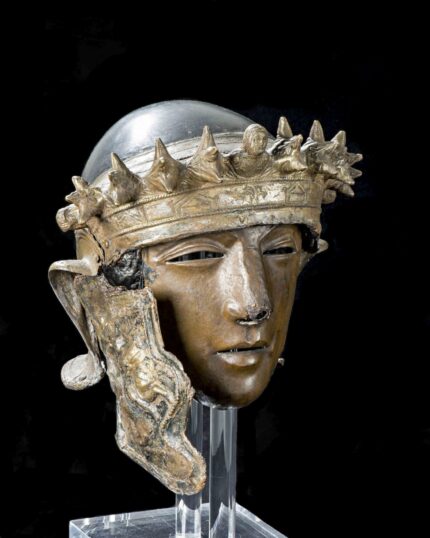 An extremely rare Roman cavalry parade mask has been discovered in Albeni, Romania. Very few of parade masks have been found in Romania and all of them were made of bronze. This is the first iron parade mask unearthed in the country. Preliminary estimates date it to the 2nd century A.D.
An extremely rare Roman cavalry parade mask has been discovered in Albeni, Romania. Very few of parade masks have been found in Romania and all of them were made of bronze. This is the first iron parade mask unearthed in the country. Preliminary estimates date it to the 2nd century A.D.
The face mask is heavily oxidized from its millennia in damp soil, but it looks to me like it’s a mask of the Kalkriese Type, characterized by its broad nose, slim eye slits, placid expression, lack of ears and a hinge at the center of the forehead joining the mask to the helmet. That semi-circular divot at the top center of the mask is where the hinge that allowed the wearer to flip it up used to be.
Here’s a spectacular example of this type of mask found in Nijmegen, the Netherlands. It is hinged to an equestrian helmet with a forehead band of high relief oak leaves referencing the corona civica military decoration. One of the cheekpieces (which the earlessness of the face mask makes possible) is still in place.
It was discovered by a metal detectorist, Betej Viorel, which is a far more unusual circumstance in Romania than it is in, say, the UK. Romania’s strict cultural heritage law requires explicit written permission from law enforcement for anyone who even wants to OWN a metal detector. If they want to use it on potential archaeological sites, they need prior written consent from the Ministry of Culture. Any object found as a result of a scan that is more than 100 years old must be given to the authorities within 72 hours. The finder then receives 30% of the assessed value of the piece as a reward. If the discovery is determined to be treasure, the reward jumps to 45% of assessed value.
Preliminary estimates date it to the 2nd century A.D. The likely source of the mask was a Roman castrum (fort) at Bumbești-Jiu, built between 102 and 106 A.D. during the Dacian wars so memorably lionized on Trajan’s Column. It was an earth and timber fort located on the bank of the Jiu river overlooking the Roman road that led through the Carpathian Mountains to Ulpia Traiana Sarmizegetusa, the capital of the Roman province of Dacia. The strategic position allowed the legionaries of the IV Cypria Cohort to monitor the river valley for any Dacian attacks coming from the mountains. The castrum soon outlived its usefulness and was abandoned after Rome’s successful conquest of Dacia. Little of the castrum remains today, and what little survived the millennia was destroyed by development in the 19th century.
The mask will be sent to the Vasile Pârvan Institute of Archaeology in Bucharest for analysis and conservation. Once the work is complete, the mask will go on permanent display in the Gorj County Museum Alexander Ștefulescu near the find site.

What is easily forgotten is that when new and in use the mask would have been silver colored and probably polished to a high finish. It might have had a light coat of oil to retard rust but it would have been pretty much indistinguishable from silver.
What is the difference between “rare” and “extremely rare”?
To me, frankly, it also looks quite similar to the one that was found at the “Kalkriese” battle site.
However, at the lower Danube, there were the Roman provinces of “Moesia superior” and “M. inferior” (i.e. ‘even lower’ Moesia), and also “Dacia” and “Thracia”, of which all four correspond to what today is Bulgaria and Romania.
In Romania, they seem to be “extremely rare”, while in Bularia they are only “rare” 😉 In what is today Plovdiv, or back them Philippopolis (Thracia), there were helmets of a similar type.
Btw, the ~230AD “Dura-Europos route map” –from what today is still Syria– describes the route via Bulgaria and Romania all the way to the the Krim peninsula, in what –despite all the Russians currently gone astray– is still Ukraine. Note that the river Danube is in Latin referred to as ‘Danubi(u)s’, while the older Greek term is ‘Ister’.
——
Παν[υσος ποτ(αμός)? μί(λια)] (Panisos river, Kamchiya)
Οδεσ[σός μί(λια) . . (Odessus, Varna, Bulgaria)
Βυβόνα [μί(λια) . . (Kavarna, Bulgaria)
Καλ[λ]ατις μί(λια) . . (Kallatis, Mangalia, Romania)
Τομέα μί(λια) λγ´ (Tomoi, Constanța, Romania)
Ἰστρος ποτ(αμός) μί(λια) μ´ (Istros, Histria, Romania)
Δάνουβις ποτ(αμός) μί(λια) . . (Danube)
Τύρα μί(λια) πδ´ (Tyras, Bilhorod-Dnistrowskyj, Ukraine)
Βορ[υ]σ[θέν]ης μί(λια) . .
Χερ[σ]όν[ησος . . (Chersonesos, Chersones, Ukraine)
Τραπ[εζοῦς . . (Chatyr-Dag)
Aρτα[ξάτα μί(λια)] . . (Feodosiya, Ukraine)
——
This Roman iron cavalry mask looks very well preserved. Is interesting that it was discovered in the Gorj county, where other than the Roman castrum at Bumbești-Jiu, I don’t remember to be other Roman settlements. I think more chances to discover other iron cavalry masks would be in the north in the Hunedoara county, where is the capital of the Roman Dacia, Sarmizegetusa Ulpia Traiana.